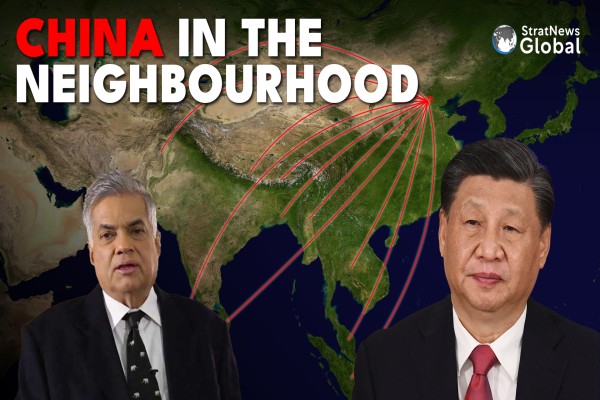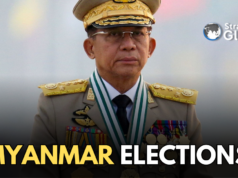China and Sri Lanka established formal diplomatic ties in 1957. The relationship has been marked by significant economic cooperation, cultural exchanges and strategic partnerships.
Sri Lanka upholds the “One China” policy, considers Taiwan and Tibet as parts of China. Sri Lanka’s engagement with China strengthened after it became an important hub on the Maritime Silk Road, a key component of China’s Belt and Road Initiative, as well as its ‘String of Pearls’ project with which China aims to gain strategic advantage over India in the Indian Ocean. China has become Sri Lanka’s primary lender, accounting for a significant portion of the country’s foreign debt.
China’s rapidly growing economic, political and strategic influence in Sri Lanka underline this relationship. Apart from President Xi Jinping’s flagship Belt and Road Initiative, Sri Lanka has joined other Chinese initiatives such as Global Security Initiative (GSI), Global Development Initiative (GDI) and Global Civilisation Initiative (GCI). Under the GSI, which was specifically designed to counter the US-led security architecture, China offers partnerships/ assistance on security related activities like counter- terrorism and cyber security cooperation.
China has requested Sri Lanka to participate in the 3rd China-Indian Ocean Region (CIOR) Forum being held in the Maldives in August, and also take the lead in establishing a forum of Small Island Nations in the Indian Ocean.
Such forums would certainly clash with India’s Security and Growth for All in the Region (SAGAR) doctrine for maritime cooperation in the Indian Ocean region, announced by Prime Minister Narendra Modi on March 12, 2015, as well as the larger Indian Ocean Rim Association, both of which have regional security high on their priority list.
Politically, apart from allegations that Beijing intervened in Sri Lanka’s domestic politics by backing Gotabaya Rajapaksa, who won the 2019 presidential elections, the CCP has been actively promoting the “Chinese model of governance” in Sri Lanka.
When Sri Lanka faced a UN Human Rights Council resolution over war crimes, China voted against it. Sri Lanka in turn seems to support the Chinese narrative on allegations of human rights violations in China, especially in Xinjiang.
In 2023, Sri Lankan exports to China were estimated at $266.57 million, a 1.83% increase compared to 2022. China exported $4.37 million worth of goods to Sri Lanka in 2022. In April 2024 alone, China exported $37 million and imported goods worth $31 million from Sri Lanka. The two countries are negotiating a Free Trade Agreement (FTA), which will further deepen Chinese penetration into Sri Lanka’s consumer market.
And then there are loans. Since the end of the civil war in 2009, China has extended loans worth $14.8 billion for Sri Lanka’s infrastructure. These include the Colombo National Performing Arts Theatre, Colombo Port City Project, Hambantota International Airport, Norochcholai Power Station, and Port City Colombo as well as the Belt and Road Initiative.
Between 2005 and 2015, China became the leading source of Official Development Assistance (ODA) and Foreign Direct Investment (FDI) in Sri Lanka, with a total of $14 billion. Most of this investment is in the form of ODA in loans and grants, primarily in sectors like energy, infrastructure and services.
Key projects include:
The development of Hambantota Port, which was leased to China in 2017 due to Sri Lanka’s inability to repay the loan. Strategically located on the global sea trade route, the port is part of China’s 21st Century Maritime Silk Road project.
The Colombo Port Project is expected to create opportunities for foreign direct investment (FDI), generate employment and increase economic activity in the region.
Norochcholai Coal Power Plant: The $1.3 billion plant is being built by the China Machinery Engineering Corporation.
Sinopec Oil Refinery: In 2022, Sri Lanka approved a $4.5 billion oil refinery proposed by Chinese state-owned company Sinopec, which will be one of the largest investments in the country in recent years.
China Merchants Group Logistics Hub: The group plans to invest $392 million in a major logistics hub at Colombo Port. The project will be connected to the Bandaranaike International Airport through Airport Expressway.
Colombo Port City Project, or the Colombo International Financial City, which has a $1.4 billion budget. The project envisages building a brand new city on land reclaimed from the sea, which will host an International Finance Centre, a duty free complex, world class hospitals and educational institutes.
India played a key role in helping Sri Lanka recover from its last economic crisis, with about $4 billion in rapid assistance between January and July, including credit lines, a currency swap arrangement and deferred import payments. All the financial assistance was handled in a very clear and transparent manner.
But unlike traditional lenders, Chinese assistance comprises high interest loans, characterised by “trouble-free technical and economic clearance”. China accounts for $4.66 billion of the $10.56 billion that Sri Lanka has borrowed from other countries. When Sri Lanka could no longer afford high-cost loans, China started cornering projects through direct investment acquiring stakes.
This has led to concerns of a possible debt trap and China’s ability to exert undue political influence. China’s investments in Sri Lanka have given it significant geopolitical leverage, with access to strategic ports, infrastructure and energy resources.
Colombo’s announcement that it would allow Chinese surveillance ships to dock in Sri Lankan ports without hindrance from next year despite strident Indian protests is seen as a measure of that growing influence.
China’s blatant disregard for environmental laws and norms while pursuing these major infrastructural projects are another area of concern. Continual oversight by technical experts is required to guard against security-related concerns and ensure public trust in the projects.
Of late, some fault lines have started surfacing in the relationship, as evinced by Colombo’s rejection of Chinese fertiliser shipments which were said to have harmful bacteria, and the refusal to let a Chinese surveillance ship dock in Colombo following Indian protests.
There have been calls from civil society in Sri Lanka for a re-evaluation of China’s geo-economic ambitions and the need for fiscal and environmental transparency in these projects. But Beijing’s rapidly growing influence in a country barely a hop and skip away from India’s southernmost tip has certainly raised several red flags in New Delhi’s South Block.
In a career spanning three decades and counting, Ramananda (Ram to his friends) has been the foreign editor of The Telegraph, Outlook Magazine and the New Indian Express. He helped set up rediff.com’s editorial operations in San Jose and New York, helmed sify.com, and was the founder editor of India.com.
His work has featured in national and international publications like the Al Jazeera Centre for Studies, Global Times and Ashahi Shimbun. But his one constant over all these years, he says, has been the attempt to understand rising India’s place in the world.
He can rustle up a mean salad, his oil-less pepper chicken is to die for, and all it takes is some beer and rhythm and blues to rock his soul.
Talk to him about foreign and strategic affairs, media, South Asia, China, and of course India.





